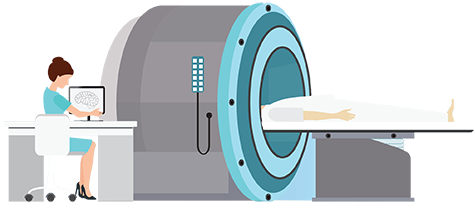

MRI technicians operate a magnetic resonance imaging machine, which creates detailed two- and three-dimensional images along any axis or plane of a patient’s body. This is accomplished through a combination of very intense magnetic fields — up to four times the strength of the earth’s magnetic field — radio pulses, and sophisticated computers. While it is possible to get detailed images of blood vessels, internal organs or soft tissues through a combination of radioactive dyes and fluoroscopy — an X-ray “movie” of sorts — MRI scans still provide the highest-quality and detailed imaging available without the risks posed by ionizing radiation.
MRI technicians are required to have a thorough understanding of their diagnostic imaging equipment as well as patience and compassion for their patients, as an MRI scan can take up to 90 minutes to complete and the patient must sit perfectly still during the scan or an image can be distorted. MRI’s are notorious for bringing on anxiety and claustrophobia in patients. Your ability to keep patients at ease before, during, and after the procedure can be of great importance.
MRI technicians may also be responsible for conducting follow-up procedures or working with radiologists to diagnose a problem. According to the Bureau of Labor Statistics, MRI technicians can expect to work full time; some may work nights or, as emergencies can occur, be on call.
Radiological technology programs can take anywhere from six months to two years to complete. Many radiological technology programs include the following subjects, in addition to the specific training required to operate an MRI machine:
There are also degree programs available in radiological technology, ranging from an associate degree to a bachelor’s degree. In addition to the in-class curriculum, programs either include training in real-life situations with an experienced MRI technicians or require practical work experience prior to enrollment.
The salary and job outlook for MRI technicians can vary from state to state, but according to the BLS, the top-paying industries for the occupation included scientific research and development services and colleges, universities and professional schools. Most radiological technicians were employed at general medical and surgical hospitals. Here’s what to expect for MRI technicians nationwide:
| Career | Annual Mean Wage | Projected Job Growth Rate |
|---|---|---|
| Magnetic Resonance Imaging Technologists | 70,490 | 13.6 |
Visit our MRI Technician Salary page to get a detailed look at salaries for MRI techs. You can also see how the salary for MRI techs compares to other radiology professions, as well as other jobs in allied health.